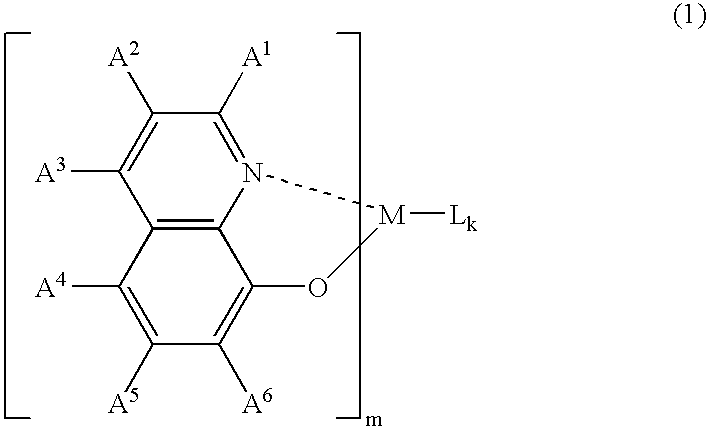Organic electroluminescence device
a technology of electroluminescence device and electroluminescence discharge tube, which is applied in the direction of discharge tube/lamp details, luminescence screen of discharge tube, natural mineral layered products, etc., can solve the problems of shortening the lifetime of half luminance, shortening the lifetime of display, and large voltage increase, so as to prolong the lifetime and suppress short circuit
- Summary
- Abstract
- Description
- Claims
- Application Information
AI Technical Summary
Benefits of technology
Problems solved by technology
Method used
Image
Examples
example 1
Present Invention
[0087]On a glass substrate, ITO was vapor-deposited in a thickness of 200 nm to form an anode layer 2 (sheet resistance: 7 Ω / □). A solution prepared by dissolving PPD of the following formula (8) (hereinafter referred to as the compound (8)) and a polyvinylcarbazole in a mass ratio of 1:2 in dichloromethane, was coated on the above anode layer 2 by a spin coating method, followed by drying to form an anode interface layer 6 having a thickness of 15 nm. Then, on the anode interface layer 6, the compound (8) was vapor-deposited in a thickness of 60 nm by a vacuum vapor deposition method to form a hole transport layer 3.
[0088]Then, Alq (host compound (A)) being the compound of the following formula (7), the compound (8) (guest compound (B)) and coumarin 545T of the following formula (9) (guest compound (C)) were, respectively, by means of separate boats, co-vapor-deposited in a thickness of 30 nm to form a light-emitting layer 4. The concentration of the compound (8) i...
example 2
Present Invention
[0091]A device was prepared and evaluated in the same manner as in Example 1 except that the construction of the light-emitting layer 4 in Example 1 was changed. Namely, Alq and coumarin 545T were, respectively, by means of separate boats, co-vapor-deposited in a thickness of 30 nm to form a light-emitting layer 4 (without using the compound (8)). The concentration of coumarin 545T in the light-emitting layer 4 was 1.0 mol %.
example 3
Present Invention
[0092]A device was prepared and evaluated in the same manner as in Example 1 except that the construction of the light-emitting layer 4 in Example 1 was changed. Namely, a light-emitting layer 4 was formed by using the same material as in Example 1 except that a compound of the following formula (10) (DCJTB) was used in an amount of 2 mol %, instead of coumarin 545T as the luminescent dye in the light-emitting layer 4 (the concentration of the compound (8) was 30 mol %). Here, DCJTB is a luminescent dye having a band gap which is smaller than the band gap of the host compound Alq.
PUM
| Property | Measurement | Unit |
|---|---|---|
| Percent by mass | aaaaa | aaaaa |
| Glass transition temperature | aaaaa | aaaaa |
| Energy | aaaaa | aaaaa |
Abstract
Description
Claims
Application Information
 Login to View More
Login to View More - R&D
- Intellectual Property
- Life Sciences
- Materials
- Tech Scout
- Unparalleled Data Quality
- Higher Quality Content
- 60% Fewer Hallucinations
Browse by: Latest US Patents, China's latest patents, Technical Efficacy Thesaurus, Application Domain, Technology Topic, Popular Technical Reports.
© 2025 PatSnap. All rights reserved.Legal|Privacy policy|Modern Slavery Act Transparency Statement|Sitemap|About US| Contact US: help@patsnap.com



